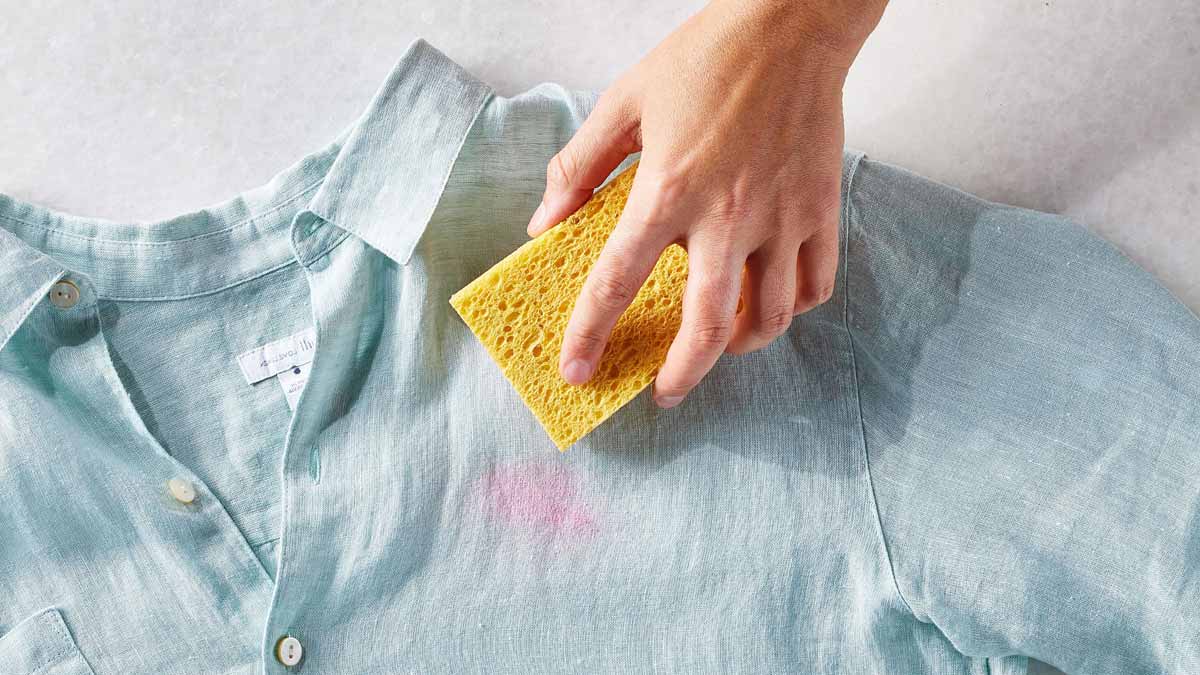Heat fixes messes in fabric fast, yet rescue remains possible when you act with care. Before another spin, slow down, check every seam, and plan your attack. Dryers lock in stains, so simple rewashes often only fade the mark. Choose the right method, respect the fabric, and keep patience. Results improve when you match chemistry to the mess, and small changes add up to big saves. Smart moves save time.
Check Before Heat : Fabric Facts and Safe Tools
Start with inspection under bright light, inside and out. Tag colorfastness as unknown until a quick test proves otherwise. Gather a soft toothbrush or nylon brush, your usual detergent, and a rack or towel for air drying. Set aside a basin and water for tests, because light reveals older rings.
Look for ink, chocolate, coffee, wine, makeup, grass, and sweat marks. Use a tiny test in a hidden seam for any color-change risk. Color-safe oxygen spot removers can still leave pale dots, so caution helps. Brush fibers gently so color lifts upward, then pause to watch for shifts before proceeding.
Map your plan by soil type. Protein or food soils respond to enzymes. Oil splashes require grease-cutting dish soap. Ink and permanent marker demand solvents initially. Stains behave differently across fibers, so select steps by fabric and soil, then progress from mild to stronger only when necessary.
Oxygen Power for Tough Stains Without Fading
Oxygen formulas rely on hydrogen peroxide to lift color bodies from fibers. Choose liquid for direct dabs or powder for sprinkling on damp fabric. Cover the mark generously, then work it gently in with the brush. Time matters, so give it ten minutes before the wash begins. Keep coverage even.
Treat spaghetti sauce, wine, chocolate, coffee, yellow sweat, makeup, and grass with this method. Use the hottest water your label allows during the cycle. Skip wool and silk, since peroxide stresses those fibers. Air dry on a rack or towel, then inspect in daylight for leftovers you might have missed.
Repeat the same steps if a shadow remains after drying. Heat can hide color when wet, so evaluate only once garments are dry. Powders need pre-dampening so granules dissolve right where you need them. Work patiently, and you often erase stains that looked permanent after a dryer pass without over-scrubbing.
Enzymes, Solvents, and Smart Pretreating Steps
Protein and starchy soils respond well to enzymatic detergent. Place a small dab directly on the spot, brush, then wait ten minutes. Wash on the hottest setting to help chemistry work. Air dry afterward, reassess, because wet fabric can disguise lingering color. That pause prevents haloing.
For pens and permanent marker, begin with rubbing alcohol or acetone. Blot, do not rub, so color lifts rather than spreads. Rinse the solvent away with water before any detergent touch. This sequence protects fibers, and it prepares the area so stains release more completely during the next cycle gently.
Prefer a spray? Choose a heavy-duty pretreater like OxiClean MaxForce. Saturate the spot fully, then wait ten minutes for light soil, or up to a week for severe marks. Wash hot if allowed, air dry again, and spot-treat a second time when any trace remains from stubborn areas as needed.
Choices for stains : Soaks, Timelines, and High-Heat Wash
Plan a soak when garments look dingy all over. Fill a clean sink or tub with warm or hot water label permits. Add oxygen product at the label rate, submerge completely, and soak for up to six hours. That patient bath loosens bonded color and prepares fibers for the cycle.
Run a normal wash after soaking with your usual detergent. Stay with hottest safe temperature, since heat in water helps release soils, unlike the dryer. Dry on a rack or towel, not with forced heat, then check results. Treat again where needed, because multiple gentle rounds beat one harsh attempt.
Some marks need a two-in-one punch. A formula combining oxygen bleach and enzymes, such as Tide Ultra Oxi, often finishes the job. Use it after the soak when color lingers, then rewash and air dry. With measured steps and calm hands, even set-in stains finally give up without harming color.
Dish Soap Tactics and Dry-Cleaner Limits
Kitchen oil, fryer splashes, and grime respond to grease-cutting dish soap. Blue Dawn works well because it targets fats. Avoid soaps with lotions, since softeners reduce cleaning power. Place a small dab on the spot, brush gently into the weave, then send the load through a hot cycle.
Air dry again and inspect. If a shadow remains, repeat the same short sequence until the fabric looks clean. For delicate fibers such as silk, wool, and cashmere, hand off the work. Professional cleaners use controlled solvents that lift color and protect texture, and they manage risky jobs safely.
Act fast, because time hardens problems. Hot air fixes color into place, and repeated washes only fade the area without removal. Check every piece before the dryer, treat early, and step up care for tricky items. Using this rhythm, fewer stains survive long enough to become permanent in your wardrobe.
Keep your favorite pieces longer
Choose the method by soil type, then test fabric in a hidden seam. Give chemistry the minutes it needs, and let garments air dry before judging, since wet color lies. Trust a cleaner when fibers are delicate or the mark is risky. With steady moves, patient timing, and the right tools, even set-in stains stop running the show. Save fibers with calm choices and avoid rushed scrubbing.
